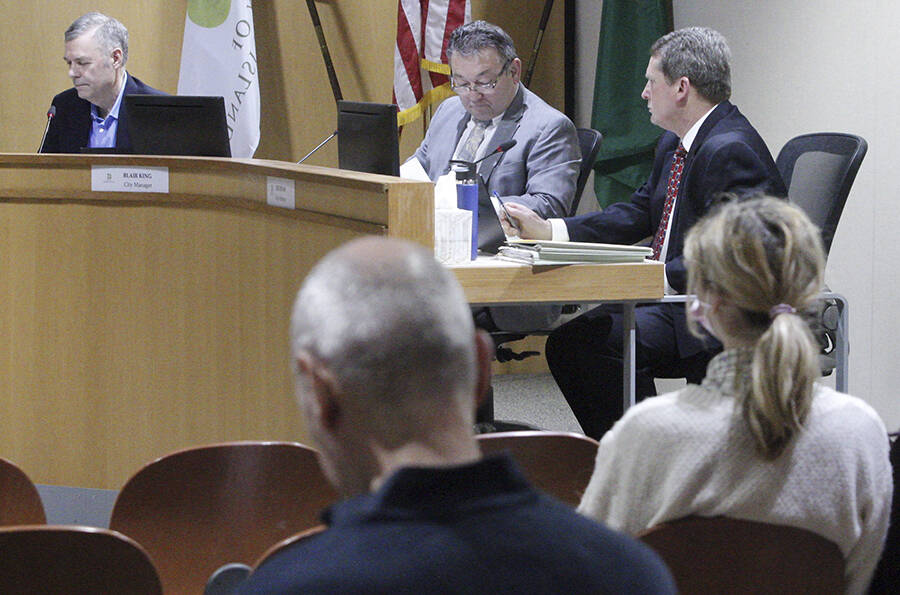Connect the dots. That’s what Scenario 2 in the Sustainable Transportation Plan will do.
The Bainbridge Island City Council selected that option at its meeting Tuesday night. It was historic in that it was the first meeting in-person at City Hall in about two years because of COVID-19. About 20 people attended. “It seems like old times,” Councilmember Clarence Moriwaki said.
Councilmember Leslie Schneider said the second option was the best of three in that it connects neighborhood centers. “It creates high-quality infrastructure to places that matter to us,” she said.
She added that it “appeals to people who don’t bike right now” and she wonders how many visitors it will convince to not “bring their cars on the island.” She also said it’s a living document so she hopes more off-road paths can be added.
Deputy Mayor Brenda Fantroy-Johnson said there are many more projects being planned to “make transportation better.”
Mayor Joe Deets said, “it’s not the end but it’s the start of a very deliberate process” that will include getting the community involved.
Public Works director Chris Wierzbicki said the city reached out to the climate change committee, which wanted to emphasize reducing gas emissions, and the racial equity committee, which hoped for a broader outreach to the public.
Wierzbicki quickly described the three scenarios.
The first was “status quo,” looking at what the city has spent the past 10 years and planning strategic improvements based on spending that same amount the next 10 years.
The option that was ultimately approved is a six-year plan created for all ages and abilities to connect neighborhood centers.
The third option was for 10 years and would stretch dollars out further over a larger area.
During public comments, Demi Allen said he likes option 2’s connectivity as it creates a core network that can be built up over time. He also likes that it can be used by a wide range of people and that it finally supports the Comprehensive Plan of 2016.
Alyse Nelson was the only online commenter as the rest were in the live audience. She said she likes option 2 as it’s for all abilities. It provides safe and convenient places to ride so people have “a choice in how to get around.” As a bicyclist, she and others have been frustrated by the slow process so they’re eager to see the council adopt the Sustainable Transportation Plan.
Peter Harris had been a supporter, but he gave many good reasons to pick option 3.
Harris said option 2 is not less expensive than 3 as it looks on paper; it costs the same so it would require higher taxes sooner. He says option 3 tries to increase safety and reduce gas emissions now, while option 2 saves that for later while making a few roads “highly attractive” to sell the idea of non-motorized travel.
Many like option 2 because of its connectivity, but Harris says population in the community centers isn’t enough to support that option. He compared it to the Sound to Olympics Trail at High School Road and Highway 305. Due to a lack of population nearby, it is used very little so it doesn’t have much impact on reducing gas emissions, he said. People who live in the community centers don’t want them to grow; they want to stay rural. So option 3 would be better because if the centers do grow the improved connections could then be made with increased tax revenue from that growth, he says.
Meanwhile, option 3 increases road safety and would allow more people to use their bicycles now. Harris goes on to say option 3 provides five times the mileage improvements of the second option, which deals with areas of the island that already are safe.
To conclude, he says: “Will you try to sell a holistic vision containing all our values, commit to land-use changes before the next Comp Plan and promise to address climate change sometime in the future when convenient? Or will you show a practical way to increase road safety to do the city’s job, help people throughout the island and reduce gas emissions now?”
Roundabouts
The meeting opened with a slide show from the state Department of Transportation regarding the two planned Highway 305 roundabouts. It was explained that the highway is congested, and the roundabouts would improve traffic flow and safety.
During public comments, three people supported them.
Bob Stevenson, who lives near where one of the roundabouts would be, said they are needed. He said he has two children, and he “prays every day for their safety” because of how dangerous the highway is.
Another said it’s the city’s responsibility to make sure everyone is safe. He also said roundabouts are better than stoplights that create parking lots in both directions as people wait. Another said people need to get out of their cars, and public bus service needs to improve.
In a handout given to the Review, Doug Rauh says the roundabouts will just bring fewer trees and more asphalt. He said they will make it nearly impossible to get onto Highway 305 when cars get off the ferry. And he said reducing the speed limit before reaching the roundabouts will not reduce travel time or improve capacity.
Rauh questioned the need for 15-foot wide sidewalks when there is little foot traffic in the area. He also said changing the retention pond from north-south to east-west would save trees.
Welcome signs
City manager Blair King then talked about “Welcome” signs that have been placed around BI. They were approved in early 2021 but because of COVID and other factors, the effort hadn’t been celebrated.
Fantroy-Johnson said working with the city’s racial equity committee she kept hearing that BI is very “welcoming” so she thought, “Let’s let the rest of the world know that.”



